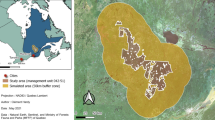Abstract
Forest-related activities are important as the economic and social drivers for local residents in Okinawa Island. Therefore, strategic timber management planning is a prerequisite to achieve a sustainable timber yield and optimize forest resource utilization. In this study, the practicability of the Timber Harvest Simulation Model (HARVEST) developed by Eric Gustafson from USDA was tested with the aim of assessing the spatial pattern consequence of timber management plans in the subtropical Yambaru Forest of Okinawa Island. HARVEST evaluates options for timber harvesting by providing comparable predictions of age effect, forest spatial distribution and forest edge habitat, as well as patch structure in a targeted forest type and management area. The timber harvest simulation in 2.1 % of the Yambaru timber production areas was investigated using two alternative cutting methods (clustered and dispersed). It was found that small-area clear-cut harvesting, mimicked by a clustered method, was the practical harvesting practice in Yambaru with an estimated timber volume 12 % higher than that from the selective-logging mimicked by the dispersed method. The mean patch size of the harvested area and forest edge habitat were significantly correlated with timber harvesting method. In spite of some limitations quantified in the model, information generated from HARVEST model was applicable and practical for many forest stakeholders and effective for time-and-cost consideration.






Similar content being viewed by others
References
Bremer LL, Farley KA (2010) Does plantation forestry restore biodiversity or creates green deserts? A synthesis of the effects of land-use transitions on plant species richness. Biodivers Conserv 19(14):3893–3915
Department of Agriculture, Forestry and Fisheries (DAFF) of Okinawa Prefecture (2011) Annual report of forest and forestry of Okinawa, Naha, Japan (in Japanese)
Forestry Agency (2012) Forestry White Papers. Ministry of Agriculture, Forestry and Fisheries, Japan. Annual report submitted to the National Government each fiscal year, Tokyo
Fujii S, Kubota Y, Enoki T (2010) Long-term ecological impacts of clear-fell logging on tree species diversity in a subtropical forest, southern Japan. Jpn For Resour 15(5):289–298
Gustafson EJ (1998) Clustering timber harvests and the effect of dynamic forest management policy on forest fragmentation. Ecosystems 1(5):484–492
Gustafson EJ, Crow TR (1996) Simulating the effects of alternative forest management strategies on landscape structure. J Environ Manage 46(1):77–94
Gustafson EJ, Rasmussen LV (2002) Assessing the spatial implication of interaction among strategic forest management options using a window-based harvest simulator. Comput Electron Agric 33(3):179–196
Gustafson EJ and Rasmussen LV (2005) HARVEST for Windows v6.1: User’s guide. Published on the Internet by the USDA Forest Service, North Central Research Station, Rhinelander. http://www.nrs.fs.fed.us/tools/harvest/harv61User.pdf. Accessed 20 Feb 2013
Gustafson EJ, Lytle DE, Swaty R, Loehle C (2007) Simulating the cumulative effects of multiple forest management strategies on landscape measures of forest sustainability. Landsc Ecol 22(1):141–156
Ito Y (1997) Diversity of forest tree species in Yambaru, the northern part of Okinawa Island. Plant Ecol 133(2):125–133
Ito Y (2003) Rich biota in the forests of Yanbaru, northern montane part of Okinawa island Japan, and imminent extinction crisis of the endangered species. In: Proceedings of IUFRO Kanazawa 2003 “Forest Insect Population Dynamics and Host Influence”, pp 11–15
IUCN Redlist of threatened bird species (2013). http://www.iucnredlist.org/. Accessed Oct 2013
Jemali NJN, Shiba M, Zawawi AA (2013) Comparison of image classification methods using IKONOS image for identifying land cover attributes of logged over forest area in Yambaru, Okinawa Island. J Jpn For Eng 28(1):99–105
Kubota Y, Katsuda K, Kikuzawa K (2005) Secondary succession and effects of clear-logging on diversity in the subtropical forests on Okinawa Island, southern Japan. Biodivers Conserv 14(4):879–901
Leefers LA, Gustafson EJ, Freeman P (2003) Linking temporal-optimization and spatial–simulation models for forest planning. In: Arthaud GJ, Barret TM (eds) System analysis in forest resources. Kluwer Academic Publishers, Dordrecht, pp 165–173
Li H, Franklin JF, Swanson FJ, Spies TA (1993) Developing alternative forest cutting patterns: a simulation approach. Landsc Ecol 8(1):63–75
Okinawa Development Agency (2003) The Dams of Yambaru: operation and management. Okinawa General Bureau, North Dam Integrated Control Office, Naha, Japan
Pinendo-Vasquez M, Zarin DJ, Coffey K, Padoch C, Robelo F (2001) Post-boom logging in Amazonia. Human Ecol 29(2):219–239
Ripple WJ, Bradshaw GA, Spies TA (1991) Measuring landscape pattern in the Cascade Range of Oregon, USA. Biol Conserv 57(1):73–88
Ryukyu Shimpo (2013) http://english.ryukyushimpo.jp. Accessed 24 Feb 2013
Shifley SR, Thompson FR, William DD, Fan ZF (2008) Forecasting landscape-scale, cumulative effects of forest management on vegetation and wildlife habitat: a case study of issues, limitations, and opportunities. For Ecol Manage 254(3):474–483
Shinohara T (1999) Studies on the forest resources and timber production in Okinawa Prefecture. Sci Bull Fac Agric Univ Ryukyus 46:37–50 (in Japanese)
Shinohara T, Florence R, Asato I (1996) Some observation on forests and forestry on the Ryukyuan Islands. Sci Bull Fac Agric Univ Ryukyus 43:31–41 (in Japanese)
Tang SM, Gustafson EJ (1997) Perception of scale in forest management planning: challenges and implications. Landsc Urban Plan 39(1):1–9
Acknowledgments
We would like to thank the Forestry Department of Okinawa Prefecture and Eric Gustafson for providing advice, assistance and comments during this research. The financial support from the Ministry of Education of Malaysia and the Female Research Grant (No. 148) from the United Graduate School of Kagoshima University is much appreciated.
Author information
Authors and Affiliations
Corresponding author
Rights and permissions
About this article
Cite this article
Jemali, N.J.N.B., Shiba, M. & Zawawi, A.A. Strategic Forest Management Options for Small-Scale Timber Harvesting on Okinawa Island, Japan. Small-scale Forestry 14, 351–362 (2015). https://doi.org/10.1007/s11842-015-9292-z
Accepted:
Published:
Issue Date:
DOI: https://doi.org/10.1007/s11842-015-9292-z




